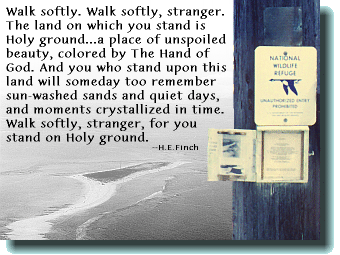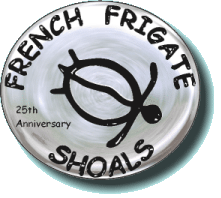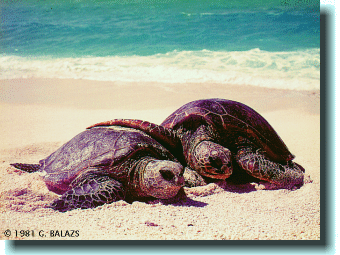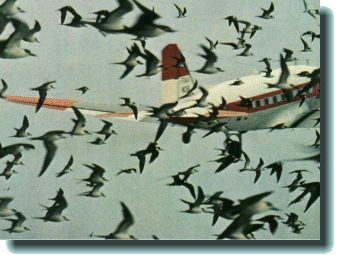
Poem by Harry Emmett Finch

|
Contents of this page
|
In December 1997, we were checking some facts in Synopsis of Biological Data on the Green Sea Turtle in the Hawaiian Islands, an October 1980 paper written by George H. Balazs of the National Marine Fisheries Service (Honolulu). One sentence in particular caught our attention:
"Nesting takes place at French Frigate Shoals only on the islands of East, Whale-Skate, Trig, Tern, Gin, and Little Gin. Of the females present for each breeding season, approximately 55% nest on East Island and 35% next on Whale-Skate. East Island has consequently been the site of intensive research during each breeding season since 1973 with surveys being made at regular intervals on the other islands."
By means of simple arithmetic, we realized that 1998 marks the 25th anniversary of the French Frigate Shoals sea turtle research operation. We believe that is something special in Hawaii's natural history and should be celebrated. Turtle Trax is pleased to kick off our part of this celebration.
The French Frigate Shoals tagging operation celebrates its Silver Anniversary on June 1, 1998. Since 1973, research conducted there has revealed much about the mating, nesting and migratory habits of the Hawaiian green turtle. We’ll try our best to share some of this information with you.
The tagging of turtles at the French Frigate Shoals is a marvellous success story. The number of nesting females continues to grow steadily as the honu population struggles its way back to recovery. They've had plenty of help along the way, thanks to the dedicated team of researchers and volunteers at the both Federal and State levels.
According to the Synopsis, nesting for Hawaiian green sea turtles (‘honu’) begins during the middle of May, reaches its peak in late June, and declines to a very low level by early August. Some sporadic nesting has been recorded as late as September however.
Once we decided to create a 25th Anniversary Celebration page, we needed to determine what day in 1998 would be the official anniversary day. We're fortunate enough to know George Balazs, so we asked him. Here's his reply:
"I just went to my 1973 fieldnote book. I flew there for the first time on June 1, 1973. We set down on Tern Island at about 12:15 pm. I walked the Tern Island beach that night. No signs of turtle nesting observed.
On June 3, 1973 I first set foot on East Island, setting up a tent and small campsite. I went out to search for turtles at 7:15 pm (sunset was 7:50 pm--as it still is). No turtles up nesting as yet...
Turtles were encountered and tagged that night on subsequent walkarounds, but not many of course compared to now."
It was a toss up between the two days, June 1st (first arrival at the FFS) or June 3rd (first time at East Island, where most nesting occurs). Which day should be celebrated? Again, we asked George. In reply, he wrote:
"I prefer June 1 because it's the "1st" of the month, because that's the day my eyes saw the Shoals and my feet and heart touched its soil, and because I did do a turtle survey (on Tern) that day (no nesting signs found)."
That settled it. The French Frigate Shoals tagging operation will celebrate its 25th Silver Anniversary on June 1st, 1998. Since 1973, much has been learned there about the mating, nesting and migratory habits of the Hawaiian green sea turtle.

|
| Basking honu, East Island, 1981 |
George Balazs' Synopsis describes East Island and Whale-Skate as the two largest naturally occurring islands at the French Frigate Shoals. From 1944 to 1952, East Island was the site of a 26-man U.S. Coast Guard navigation (LORAN) station. Although some clean-up activities took place in 1965 and 1973, remains of this abandoned facility are still prominent on the island.
Tern Island, located 11 km to the northwest of East Island, is a reconstructed island that was enlarged by dredging and landfill from 4.5 to 23 hectares in 1942. From the air, Tern Island looks for all the world like an aircraft carrier accidentally run aground (124K JPEG) on the shallows of these pimples in the Pacific.
When we began looking for information on the French Frigate Shoals, we weren't optimistic. After all, these tiny islands aren't called shoals for nothing. If the French Frigate Shoals could be described in one word, that word would be remote. In fact, it's doubtful you could get more remote than this. Imagine our surprise and happiness to discover the French Frigate Shoals web pages produced by Lt. Jerry M. Lentz, US Coast Guard (Retired)! In his description, Jerry confirms that the French Frigate Shoals are indeed thought to be the ends of the earth:
Within the Coast Guard, French Frigate Shoals was the ultimate isolated duty, often referred to when threats were made to ship someone to the middle of nowhere. Today, the island is inhabited by a small research team of 2 biologists. You cannot visit the island on your own because all the islands from Nihoa to the Pearl & Hermes Reef are part of the Hawaiian National Wildlife Refuge and any intrusion is strictly forbidden.
Jerry has a lot more interesting material about the history of the Shoals, both natural and man-made. Make sure you visit this neat set of pages. Be sure to sign the guestbook, and tell Jerry we sent you! Jerry is also developing pages documenting the aviation history of the FFS. Be sure to drop by!
On June 1, the day chosen as the official anniversary, George H. Balazs, the man who was there at the beginning and who is still very much involved 25 years later, posted the following on the CTURTLE mailing list:

N36 and sooty terns
Photo: National Geographic, 1978Due to some good luck, perseverance and a year or two of dreaming about it, 25 years ago today I touched sand for the first time at French Frigate Shoals. A DC-3 "Gooney Bird" aircraft, of World War II vintage, put us down on the 3000' Tern Island gravel runway. Ironically the landing was made through a mass of swirling sooty terns (see National Geographic, May 1978).
I had traveled to these remote islets 500 miles up the Hawaiian chain from Honolulu to start a systematic tagging and monitoring study of the green turtles nesting there. One that would, I had hoped, last for "three years" with seed-money kindly granted by the New York Zoological Society under Dr. Wayne King.
Not much was known then about such things as how many green turtles nested in Hawaii, what nesting cycles they displayed, the turtles' dispersal throughout Hawaii (or maybe elsewhere in the Pacific), growth rates of the youngsters, and time to maturity. However, what was clearly known at that time, in Honolulu and on Maui and other inhabited islands of Hawaii, was that a good market and high price existed in the restaurant trade for green turtle meat. And that the turtles had no legal protection and could be caught pretty easily in certain places using modern scuba gear and relatively cheap synthetic tangle nets.
I would have scarcely remembered this date of June 1st, or given it any notice, had it not been for Ursula Keuper-Bennett's sharp eye for historical moments, and deep appreciation for the Hawaiian honu that husband Peter and her dive with each summer off of Maui. And talk about frequently on Cturtle. Thank you Ursula and Peter, for your involvement and for your affectionate website segment on French Frigate Shoals. During the 25 years of our tagging and monitoring program (the 26th season this year), much has been learned almost entirely through the collaboration, partnerships, and friendships built with other researchers and lay persons. Peter and Ursula exemplify in the finest fashion a portion of those many individuals.
For these past 25 years the tagging of turtles to achieve individual or cohort recognition has been the "gold-standard" foundation of our work. About 2000 nesting greens have been tagged and nearly 3900 others, mainly immatures, in numerous Hawaiian coastal foraging habitats. However, technological advances in tags, and our current financial ability to purchase them, have allowed us to now exclusively use PIT tags. The chances appear to be greater for these tags to be retained by our turtles when another 25 years pass by.
Based on our annual number of nesters, and in-water sampling of immatures, and anecdotal reports by recreational divers, green turtles in Hawaii show very encouraging signs of population recovery since being protected in 1978 under the US Endangered Species Act. Yes, we have this nagging tumor problem that is severe in individuals at many locations. The work on this disease is essential and continues by an array of respected pathologists, virologists and epidemiologists. Far better today, however, to look at the bright side. The numbers are up throughout Hawaii. And the road to population recovery is indeed possible, given some patience, the passage of time, and hard work by many individuals respecting one another's diversity of opinions, talents and efforts.
Aloha, George Balazs